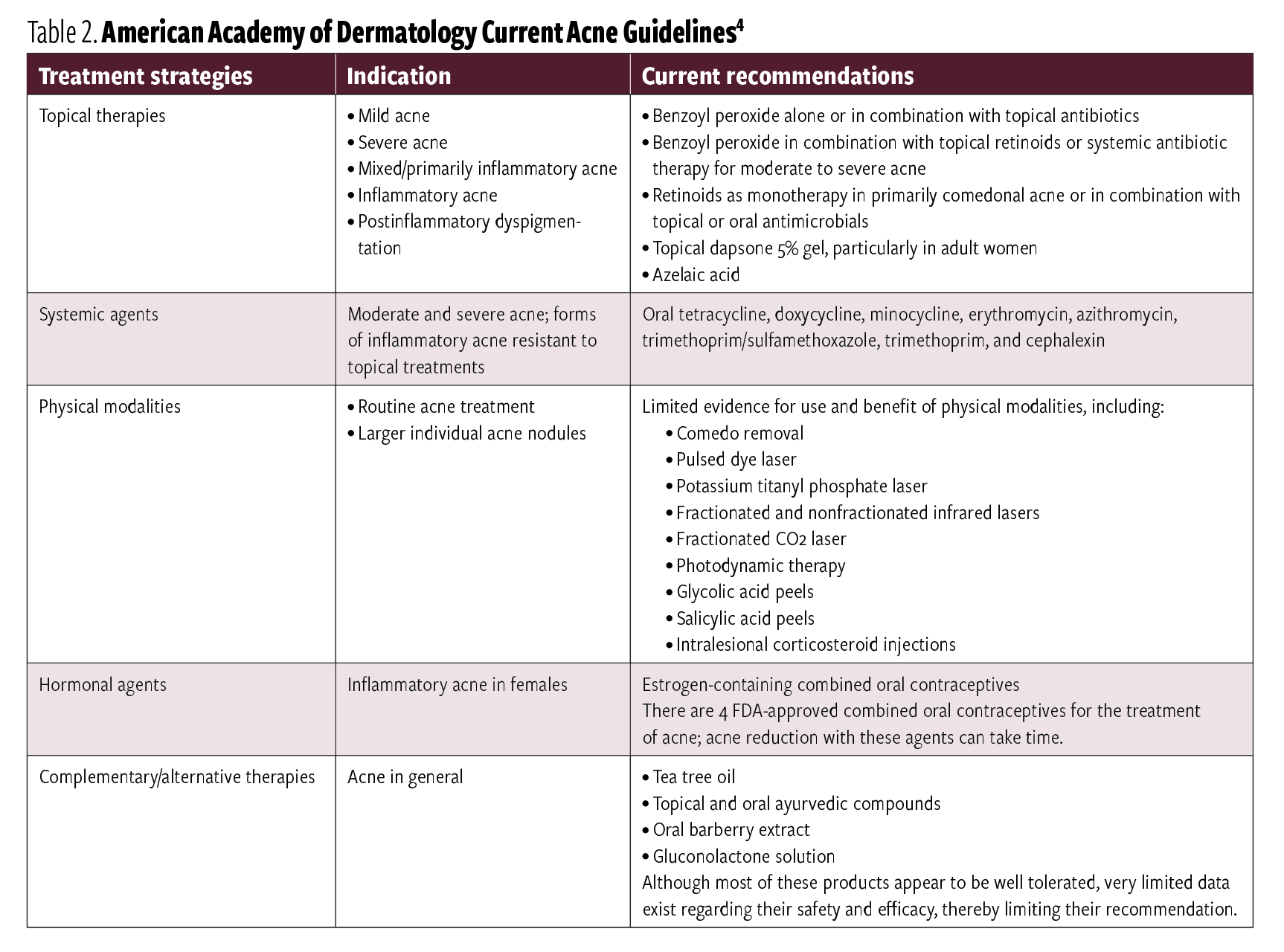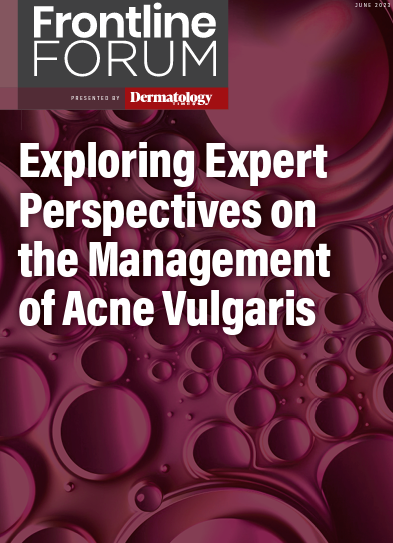- Case-Based Roundtable
- General Dermatology
- Eczema
- Chronic Hand Eczema
- Alopecia
- Aesthetics
- Vitiligo
- COVID-19
- Actinic Keratosis
- Precision Medicine and Biologics
- Rare Disease
- Wound Care
- Rosacea
- Psoriasis
- Psoriatic Arthritis
- Atopic Dermatitis
- Melasma
- NP and PA
- Skin Cancer
- Hidradenitis Suppurativa
- Drug Watch
- Pigmentary Disorders
- Acne
- Pediatric Dermatology
- Practice Management
- Prurigo Nodularis
- Buy-and-Bill
Publication
Article
Dermatology Times
Frontline Forum Part 2: Exploring Expert Perspectives on the Management of Acne Vulgaris
Author(s):
In part 2 of this Frontline Forum series, Neal Bhatia, MD; Dawn Eichenfield, MD, PhD; Lawrence Eichenfield, MD; Linda F. Stein Gold, MD; and Guy Webster, MD, PhD, discuss the practical and clinical considerations in the management of acne vulgaris, reviewing available treatment options and how to treat acne scars.
Additional Treatment Options
Isotretinoin may not always be effective for all patients, and as such it is important to consider additional options. Lawrence Eichenfield highlighted the utility of clascoterone cream 1% (Winlevi®; Sun Pharmaceutical Industries), whereas Stein Gold said she believes hormonal therapy is beneficial for women who suffer from acne.
One piece of advice regarding any acne treatment regimen is to keep it simple to help keep patients motivated, Stein Gold commented, because complicated skin care regimens can be overwhelming. She said clinicians should remind patients not to exfoliate the skin vigorously; instead, patients should use a gentle cleanser, moisturizer, and sunscreen. Webster told his colleagues that he finds it easier for patients to use a medicated facial cleanser in the shower. “The patient puts it on before showering and then washes it off while showering,” he said. “The cleanser sticks more because it’s been on longer.”
The panel also touched on the role that diet and food play in acne. They noted that foods that cause a high glycemic index, like whey protein, are more likely to exacerbate acne eruption. Dawn Eichenfield said parents often ask her if changes to their teen’s diet will improve their skin appearance. Although eating healthy helps, she remarked, “as a whole, there’s not a lot of evidence to show that there is a [correlation], that chocolate causes acne or something like that.”
Systemic Acne Treatments
Stein Gold is currently helping update the American Academy of Dermatology guidelines (Table 2) for acne, which she said includes a generous literature review.
Table 2

The panel emphasized the importance of individualizing care. For instance, Lawrence Eichenfield noted that systemic acne treatment for patients in their mid-teenage years should be severity based. On the other hand, Stein Gold said an oral hormonal therapy and a topical therapy might be appropriate for a 20-year-old woman with acne.
Bhatia thinks topicals are generally underutilized. “I still think there’s a real resistance among dermatologists to not optimize all the topicals they can,” he said. “They switch to antibiotics a little too quickly.”
Stein Gold has been an investigator in studies evaluating topical fixed combinations with oral antibiotics. “The efficacy of oral antibiotics alone, especially with the older tetracycline-class drugs as monotherapy, is not good at all,” she said. “It’s definitely better to use a good topical in combination with an oral antibiotic.”
Another option is spironolactone, the panel noted. Although this drug has become more popular, “we may not be as enthused with its efficacy in younger teens as in the adult world,” Lawrence Eichenfield cautioned. “Younger teens may not necessarily [experience] as profound an effect and perhaps end up [taking] other systemic agents like isotretinoin.”
With that in mind, Dawn Eichenfield reserves spironolactone for adult women because of its efficacy. For an additive effect, she often includes an oral contraceptive pill, if not contraindicated.
Clascoterone as a Treatment Option
The panel agreed that clascoterone cream 1%, an FDA-approved antiandrogen medication used topically as a cream for acne treatment in patients 12 years and older,3 is a useful tool. Lawrence Eichenfield finds it to be a well-suited vehicle because it is topical and not systemic, and it blocks dihydrotestosterone (DHT) but does not cause secondary hormonal problems. Meanwhile, Stein Gold said clascoterone is an appealing vehicle because it does not increase dryness and scaling like several other topical acne medications can do.
Unlike other options, Webster said, clascoterone has an established mechanism for acne and rosacea. He prescribes it when other treatments have been shown to be ineffective.
“Its mechanism, though, probably limits itself to a different type of acne,” Bhatia clarified. “Perhaps [it’s] more effective on the lower face than the upper face, or superior in boys than [in] girls. It is up to us to use the medicine and decide.”
Dawn Eichenfield believes clascoterone is an effective treatment for patients interested in hormonal therapy but who are not candidates for oral contraceptive pills and/or spironolactone (or who do not want to take oral contraceptive pills and spironolactone).
The one pathogenesis pillar “we could never hit topically was the reduction of sebum,” Stein Gold said. With results from in vitro studies, “we have shown potentially that [clascoterone] inhibits DHT and potentially decreases not only the production of sebum but the downstream effects of inflammation and proinflammatory cytokines. This is a unique mechanism of action.”
The wordinhibitoralso needs to be mentioned when discussing androgens. “Otherwise, patients will freak out and say, ‘It is going to take away my androgens,’ which it does not,” Bhatia said.
Findings from in vitro studies also show that clascoterone decreases transcription of androgen-promoting gene expression, Lawrence Eichenfield noted.
“But it’s the exertion of the complex that is stronger than testosterone,” Bhatia said. “That’s really the essence of clascoterone.”
Bhatia noted that clascoterone can be applied to small surface areas or on the whole face because it is very versatile as a spot treatment and there is no interaction with other treatments.
Disclosure
This Frontline Forum is supported by Sun Pharmaceutical Industries Ltd.
References
3. Hebert A, Thiboutot D, Stein Gold L, et al. Efficacy and safety of topical clascoterone cream, 1%, for treatment in patients with facial acne: two phase 3 randomized clinical trials. JAMA Dermatol. 2020;156(6):621-630. doi:10.1001/jamadermatol.2020.0465






